 | |  | |  Description Description
This page explains the general aspects of grids based on Data Providers or Procedures. These nodes are a particular case of Grid node and Grid (SD) nodes, so bear in mind that this page contains information only about things specific to this type of grid. If you can't find information about a certain functionality that may be a generic grid functionality, check the Grid node or Grid (SD) page.
A grid is defined to be "based on a Data Provider or Procedure" when it doesn't contain attributes and has a data provider or procedure set in the Data source property. To simplify the process of creating this type of grid, the Add Grid From Data Provider action and Add Grid From Procedure action were created.
Data Providers and Procedures allow the developer to encapsulate a navigation, to make a dataset independent from its source, and, sometimes, to improve performance when retrieving this data.
If the Data Provider or Procedure used in a grid defines parameters to control filtering, changing of the resulting order, or paging, K2BWebPanelDesigner will try to map its own variables relating to filters, orders and paging when invoking it.
The runtime appearance of a grid "based on a Data Provider or Procedure" is equal to the appearance of a generic Grid node or Grid (SD).
In this section only properties specific to grids based on Data Providers are shown. Generic properties for grids can be found on the generic grid documentation.
Ir order to understand how these grids work, let's take a look at an example. Below, rules and code for a Data Provider named ProductDataProvider are shown.
 |
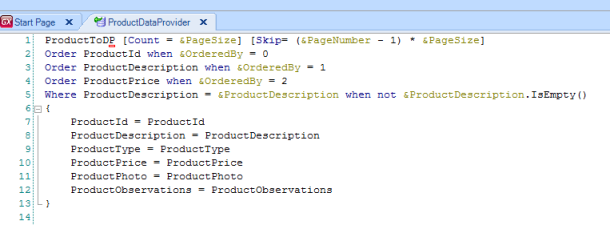 |
| Rules |
Source |
As you can see this dataprovider has parameters that allow changing the order of the returned items, filtering by the item's description, and manage paging.
PageNumber contains the index of the page that should be returned, and PageSize is the size of each page. This is acomplished inside the Data Provider by including the code shown at the top of the source code included above.
The output of this dataprovider is the SDT shown below.
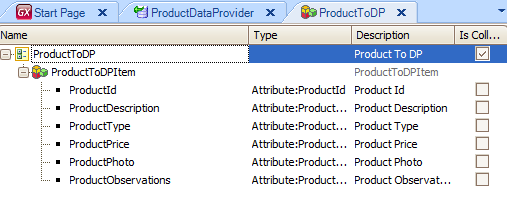 |
| Output SDT |
In K2BWebPanelDesigner, the following structure was generated to include a grid based on this Data Provider.
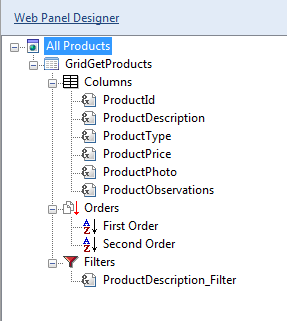 |
| Web Panel Designer |
As you can see, the grid defined has variables, filters and orders. The load code K2BWebPanelDesigner generated for this grid is shown below.
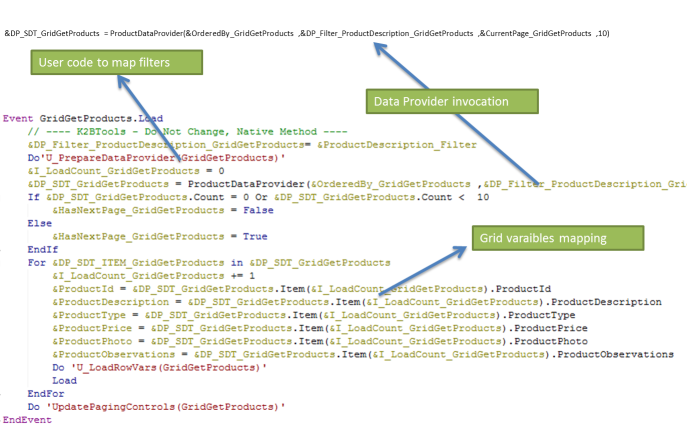 |
| Data Provider Load Code |
The most important part of this source code is when it invokes the DataProvider or Procedure. The object called receives parameters values based on the mappings defined below.
Data providers always return the result set in their last parameter. Procedures, however, may return it as the last parameter or, when created using the OpenAPI import tool, in the third parameter counting from the last one.
The heuristic that K2BTools uses to determine what parameter is the output one for Procedures, is:
- If the first parameter is named "ServerUrlTemplatingVar" then, the output parameter is the third parameter starting from the last one
- Otherwise, the output parameter is the last one
To map K2BWebPanelDesigner's "OrderBy" variable with a Data Provider or Procedure parameter, a parameter name must end with "OrderBy" or be "OrderedBy".
For each IN parameter in the Data Provider or Procedure definition, K2BWebPanelDesigner adds a variable named "DP_Filter_{parameterName}_{GridName}" to the web panel. After that, K2BWebPanelDesigner will try to map this variable to one of the filters defined for the grid.
Automatic filter mapping occurs when:
- The parameter has the name equal to a filter variable.
- The parameter has the name equal to a filter variable plus a "_Filter" literal.
In this case, before the invocation K2BWebPanelDesigner automatically matches the "DP_Filter_ProductDescription_GridGetProducts" with "&ProductDescription_Filter" filter variable.
In the event of not being able to automatically map a parameter a subroutine named "U_PrepareDataProvider({GridName})" is called before data provider invocation in order to manually map Data Provider parameters to their values.
Paging mapping:
K2BWebPanelDesigner determines that a Data Provide or Procedure has built-in paging when one of the following occurs:
Option 1: Available from K2BTools 10 onwards
The object parameters contains:
- A parameter called "&Count" and
- A parameter called "&Skip".
Option 2: Deprecated from K2BTools 10 onwards (only supported in Web Panel Designer)
The object parameters follow these rules:
- The next to last parameter is called "&PageNumber".
- The last parameter is called "&PageSize".
After invoking the Data Provider or Procedure, the code generated by K2BWebPanelDesigner iterates through the resulting SDT and matches each K2BWebPanelDesigner variable with its corresponding field.
To automatically match a variable to a field from the SDT the following rules must be followed:
You can load other variables extending the user subroutine U_LoadRowVars{InternalName}
The load code depends upon wether the dataprovider has paging or not. In the example above a grid is loaded from a Data Provider that manages paging.
Let's take a look at another case, using a Data Provider that does not handle paging, as shown below.
 |
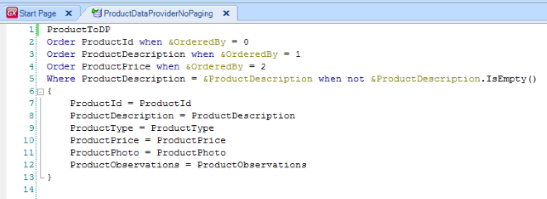 |
| Rules |
Source |
The generated Load Code in this case is:
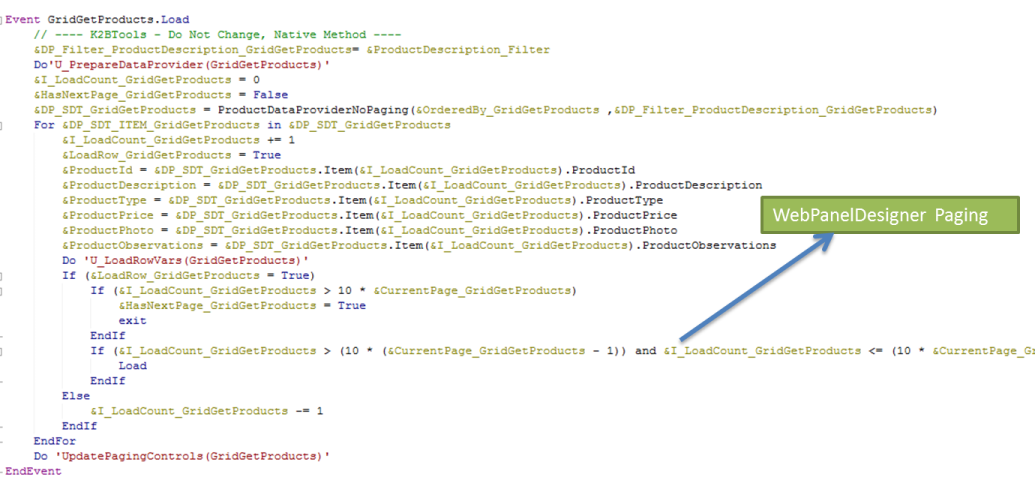 |
| Data Provider Load Code |
In this case, paging is managed by K2BWebPanelDesigner, who retrieves all records but only loads the ones specified in the current page.
The &LoadRow_{InternalName} variable can be used to prevent a row from being loaded.
In the following table, {InternalName} should be replaced with the value of the property "Name (Id)" of the grid. Only subroutines specific to this type of grid are shown. To see generic grid subroutines, check the Grid node page.
| Name |
Description |
| 'I_LoadCount_{InternalName}' |
Number of records loaded. Should not be modified by the developer. |
| 'HasNextPage_{InternalName}' |
Set to true means that grid has a next page, false if it's the last page. Should not be modified by the developer. |
| 'LoadRow_{InternalName}' |
This variable determines if the current row should be loaded. Can be changed by the developer inside 'U_LoadRowsVar{InternalName}' event. This variable is not avaiable in grids based on Data Providers or Procedures that handle paging. |
| 'DP_Filter_{ParameterName}_{InternalName}' |
This variable is associated with a dataprovider parameter. The variable value can be changed by the developer in order to decide what value the parameter should have when invoking the Data Provider or Procedure. The purpose of this variable is to map K2BWebPanelDesigner filters with the object parameters. This mapping can be done by the developper in the U_PrepareDataProvider{InternalName} subroutine. K2BWebPanelDesigner will try to automatically map filters with object parameters. For more information see "Data Provider or Procedure parameter Mapping" above. |
In the following table, {InternalName} should be replaced with the value of the property "Name (Id)" of the grid. Only subroutines specific to this type of grid are shown. To see generic grid subroutines, check the Grid node page.
| Name |
Moment of execution |
Detailed description and possible uses |
| 'U_LoadRowVars({InternalName})' |
This subroutine is invoked inside load event. |
The prupose of this subroutine is to load grid variables or actions. Also in grids based on Data Providers or Procedures which do not manage paging it can be used to determine whether to load a record or not. For this prupose a global variable named &LoadRow_Grid{InternalName} can be set to false ir order not to load that record.
|
| 'U_PrepareDataProvider({InternalName})' |
This subroutine is invoked inside load event when there are no records to load. |
The prupose of this subroutine is to map the Data Provider or Procedure parameters to its desired values. The most commun use is to map these with K2BWebPanelDesigner filter variables.
|
|